Resource Estimator を実行するさまざまな方法
この記事では、 Azure Quantum Resource Estimator を使用する方法について説明します。 Resource Estimator は、VS Code とオンラインの両方でAzure portalで使用できます。
次の表は、Resource Estimator を実行するさまざまな方法を示しています。
| ユーザー シナリオ | プラットフォーム | チュートリアル |
|---|---|---|
| Q# プログラムのリソースを見積もる | Visual Studio Code | ページの上部 にある VS Code で Q# を選択します |
| Q# プログラムのリソースを見積もる (詳細) | Visual Studio Code でのJupyter Notebook | ページの上部にある [Jupyter Notebook で Q# を選択します。 |
| Qiskit プログラムのリソースを見積もる | Azure Quantum ポータル | ページの上部にある [Azure portalで Qiskit] を選択します |
| QIR プログラムのリソースを見積もる | Azure Quantum ポータル | QIR を送信する |
| FCIDUMP ファイルを引数パラメーターとして使用する (詳細) | Visual Studio Code | 量子化学の問題を送信する |
注意
Microsoft Quantum Development Kit (クラシック QDK) は、2024 年 6 月 30 日以降サポートされなくなります。 既存の QDK 開発者の場合は、量子ソリューションの開発を続けるには、新しい Azure Quantum Development Kit (Modern QDK) に移行することをお勧めします。 詳細については、「 Q# コードをモダン QDK に移行する」を参照してください。
VS Code の前提条件
- 最新バージョンの Visual Studio Code または WEB 上の VS Code を開きます。
- Azure Quantum Development Kit 拡張機能の最新バージョン。 インストールの詳細については、「 VS Code へのモダン QDK のインストール」を参照してください。
ヒント
ローカル リソース推定ツールを実行するために Azure アカウントを持っている必要はありません。
新しい Q# ファイルをCreateする
- Visual Studio Code を開き、[ ファイル > ] [新しいテキスト ファイル ] の順に選択して、新しいファイルを作成します。
- このファイルを
ShorRE.qsとして保存します。 このファイルには、プログラムの Q# コードが含まれます。
量子アルゴリズムをCreateする
次のコードを ShorRE.qs ファイルにコピーします。
namespace Shors {
open Microsoft.Quantum.Arrays;
open Microsoft.Quantum.Canon;
open Microsoft.Quantum.Convert;
open Microsoft.Quantum.Diagnostics;
open Microsoft.Quantum.Intrinsic;
open Microsoft.Quantum.Math;
open Microsoft.Quantum.Measurement;
open Microsoft.Quantum.Unstable.Arithmetic;
open Microsoft.Quantum.ResourceEstimation;
@EntryPoint()
operation RunProgram() : Unit {
let bitsize = 31;
// When chooseing parameters for `EstimateFrequency`, make sure that
// generator and modules are not co-prime
let _ = EstimateFrequency(11, 2^bitsize - 1, bitsize);
}
// In this sample we concentrate on costing the `EstimateFrequency`
// operation, which is the core quantum operation in Shors algorithm, and
// we omit the classical pre- and post-processing.
/// # Summary
/// Estimates the frequency of a generator
/// in the residue ring Z mod `modulus`.
///
/// # Input
/// ## generator
/// The unsigned integer multiplicative order (period)
/// of which is being estimated. Must be co-prime to `modulus`.
/// ## modulus
/// The modulus which defines the residue ring Z mod `modulus`
/// in which the multiplicative order of `generator` is being estimated.
/// ## bitsize
/// Number of bits needed to represent the modulus.
///
/// # Output
/// The numerator k of dyadic fraction k/2^bitsPrecision
/// approximating s/r.
operation EstimateFrequency(
generator : Int,
modulus : Int,
bitsize : Int
)
: Int {
mutable frequencyEstimate = 0;
let bitsPrecision = 2 * bitsize + 1;
// Allocate qubits for the superposition of eigenstates of
// the oracle that is used in period finding.
use eigenstateRegister = Qubit[bitsize];
// Initialize eigenstateRegister to 1, which is a superposition of
// the eigenstates we are estimating the phases of.
// We first interpret the register as encoding an unsigned integer
// in little endian encoding.
ApplyXorInPlace(1, eigenstateRegister);
let oracle = ApplyOrderFindingOracle(generator, modulus, _, _);
// Use phase estimation with a semiclassical Fourier transform to
// estimate the frequency.
use c = Qubit();
for idx in bitsPrecision - 1..-1..0 {
within {
H(c);
} apply {
// `BeginEstimateCaching` and `EndEstimateCaching` are the operations
// exposed by Azure Quantum Resource Estimator. These will instruct
// resource counting such that the if-block will be executed
// only once, its resources will be cached, and appended in
// every other iteration.
if BeginEstimateCaching("ControlledOracle", SingleVariant()) {
Controlled oracle([c], (1 <<< idx, eigenstateRegister));
EndEstimateCaching();
}
R1Frac(frequencyEstimate, bitsPrecision - 1 - idx, c);
}
if MResetZ(c) == One {
set frequencyEstimate += 1 <<< (bitsPrecision - 1 - idx);
}
}
// Return all the qubits used for oracles eigenstate back to 0 state
// using Microsoft.Quantum.Intrinsic.ResetAll.
ResetAll(eigenstateRegister);
return frequencyEstimate;
}
/// # Summary
/// Interprets `target` as encoding unsigned little-endian integer k
/// and performs transformation |k⟩ ↦ |gᵖ⋅k mod N ⟩ where
/// p is `power`, g is `generator` and N is `modulus`.
///
/// # Input
/// ## generator
/// The unsigned integer multiplicative order ( period )
/// of which is being estimated. Must be co-prime to `modulus`.
/// ## modulus
/// The modulus which defines the residue ring Z mod `modulus`
/// in which the multiplicative order of `generator` is being estimated.
/// ## power
/// Power of `generator` by which `target` is multiplied.
/// ## target
/// Register interpreted as little endian encoded which is multiplied by
/// given power of the generator. The multiplication is performed modulo
/// `modulus`.
internal operation ApplyOrderFindingOracle(
generator : Int, modulus : Int, power : Int, target : Qubit[]
)
: Unit
is Adj + Ctl {
// The oracle we use for order finding implements |x⟩ ↦ |x⋅a mod N⟩. We
// also use `ExpModI` to compute a by which x must be multiplied. Also
// note that we interpret target as unsigned integer in little-endian
// encoding.
ModularMultiplyByConstant(modulus,
ExpModI(generator, power, modulus),
target);
}
/// # Summary
/// Performs modular in-place multiplication by a classical constant.
///
/// # Description
/// Given the classical constants `c` and `modulus`, and an input
/// quantum register |𝑦⟩, this operation
/// computes `(c*x) % modulus` into |𝑦⟩.
///
/// # Input
/// ## modulus
/// Modulus to use for modular multiplication
/// ## c
/// Constant by which to multiply |𝑦⟩
/// ## y
/// Quantum register of target
internal operation ModularMultiplyByConstant(modulus : Int, c : Int, y : Qubit[])
: Unit is Adj + Ctl {
use qs = Qubit[Length(y)];
for (idx, yq) in Enumerated(y) {
let shiftedC = (c <<< idx) % modulus;
Controlled ModularAddConstant([yq], (modulus, shiftedC, qs));
}
ApplyToEachCA(SWAP, Zipped(y, qs));
let invC = InverseModI(c, modulus);
for (idx, yq) in Enumerated(y) {
let shiftedC = (invC <<< idx) % modulus;
Controlled ModularAddConstant([yq], (modulus, modulus - shiftedC, qs));
}
}
/// # Summary
/// Performs modular in-place addition of a classical constant into a
/// quantum register.
///
/// # Description
/// Given the classical constants `c` and `modulus`, and an input
/// quantum register |𝑦⟩, this operation
/// computes `(x+c) % modulus` into |𝑦⟩.
///
/// # Input
/// ## modulus
/// Modulus to use for modular addition
/// ## c
/// Constant to add to |𝑦⟩
/// ## y
/// Quantum register of target
internal operation ModularAddConstant(modulus : Int, c : Int, y : Qubit[])
: Unit is Adj + Ctl {
body (...) {
Controlled ModularAddConstant([], (modulus, c, y));
}
controlled (ctrls, ...) {
// We apply a custom strategy to control this operation instead of
// letting the compiler create the controlled variant for us in which
// the `Controlled` functor would be distributed over each operation
// in the body.
//
// Here we can use some scratch memory to save ensure that at most one
// control qubit is used for costly operations such as `AddConstant`
// and `CompareGreaterThenOrEqualConstant`.
if Length(ctrls) >= 2 {
use control = Qubit();
within {
Controlled X(ctrls, control);
} apply {
Controlled ModularAddConstant([control], (modulus, c, y));
}
} else {
use carry = Qubit();
Controlled AddConstant(ctrls, (c, y + [carry]));
Controlled Adjoint AddConstant(ctrls, (modulus, y + [carry]));
Controlled AddConstant([carry], (modulus, y));
Controlled CompareGreaterThanOrEqualConstant(ctrls, (c, y, carry));
}
}
}
/// # Summary
/// Performs in-place addition of a constant into a quantum register.
///
/// # Description
/// Given a non-empty quantum register |𝑦⟩ of length 𝑛+1 and a positive
/// constant 𝑐 < 2ⁿ, computes |𝑦 + c⟩ into |𝑦⟩.
///
/// # Input
/// ## c
/// Constant number to add to |𝑦⟩.
/// ## y
/// Quantum register of second summand and target; must not be empty.
internal operation AddConstant(c : Int, y : Qubit[]) : Unit is Adj + Ctl {
// We are using this version instead of the library version that is based
// on Fourier angles to show an advantage of sparse simulation in this sample.
let n = Length(y);
Fact(n > 0, "Bit width must be at least 1");
Fact(c >= 0, "constant must not be negative");
Fact(c < 2 ^ n, $"constant must be smaller than {2L ^ n}");
if c != 0 {
// If c has j trailing zeroes than the j least significant bits
// of y won't be affected by the addition and can therefore be
// ignored by applying the addition only to the other qubits and
// shifting c accordingly.
let j = NTrailingZeroes(c);
use x = Qubit[n - j];
within {
ApplyXorInPlace(c >>> j, x);
} apply {
IncByLE(x, y[j...]);
}
}
}
/// # Summary
/// Performs greater-than-or-equals comparison to a constant.
///
/// # Description
/// Toggles output qubit `target` if and only if input register `x`
/// is greater than or equal to `c`.
///
/// # Input
/// ## c
/// Constant value for comparison.
/// ## x
/// Quantum register to compare against.
/// ## target
/// Target qubit for comparison result.
///
/// # Reference
/// This construction is described in [Lemma 3, arXiv:2201.10200]
internal operation CompareGreaterThanOrEqualConstant(c : Int, x : Qubit[], target : Qubit)
: Unit is Adj+Ctl {
let bitWidth = Length(x);
if c == 0 {
X(target);
} elif c >= 2 ^ bitWidth {
// do nothing
} elif c == 2 ^ (bitWidth - 1) {
ApplyLowTCNOT(Tail(x), target);
} else {
// normalize constant
let l = NTrailingZeroes(c);
let cNormalized = c >>> l;
let xNormalized = x[l...];
let bitWidthNormalized = Length(xNormalized);
let gates = Rest(IntAsBoolArray(cNormalized, bitWidthNormalized));
use qs = Qubit[bitWidthNormalized - 1];
let cs1 = [Head(xNormalized)] + Most(qs);
let cs2 = Rest(xNormalized);
within {
for i in IndexRange(gates) {
(gates[i] ? ApplyAnd | ApplyOr)(cs1[i], cs2[i], qs[i]);
}
} apply {
ApplyLowTCNOT(Tail(qs), target);
}
}
}
/// # Summary
/// Internal operation used in the implementation of GreaterThanOrEqualConstant.
internal operation ApplyOr(control1 : Qubit, control2 : Qubit, target : Qubit) : Unit is Adj {
within {
ApplyToEachA(X, [control1, control2]);
} apply {
ApplyAnd(control1, control2, target);
X(target);
}
}
internal operation ApplyAnd(control1 : Qubit, control2 : Qubit, target : Qubit)
: Unit is Adj {
body (...) {
CCNOT(control1, control2, target);
}
adjoint (...) {
H(target);
if (M(target) == One) {
X(target);
CZ(control1, control2);
}
}
}
/// # Summary
/// Returns the number of trailing zeroes of a number
///
/// ## Example
/// ```qsharp
/// let zeroes = NTrailingZeroes(21); // = NTrailingZeroes(0b1101) = 0
/// let zeroes = NTrailingZeroes(20); // = NTrailingZeroes(0b1100) = 2
/// ```
internal function NTrailingZeroes(number : Int) : Int {
mutable nZeroes = 0;
mutable copy = number;
while (copy % 2 == 0) {
set nZeroes += 1;
set copy /= 2;
}
return nZeroes;
}
/// # Summary
/// An implementation for `CNOT` that when controlled using a single control uses
/// a helper qubit and uses `ApplyAnd` to reduce the T-count to 4 instead of 7.
internal operation ApplyLowTCNOT(a : Qubit, b : Qubit) : Unit is Adj+Ctl {
body (...) {
CNOT(a, b);
}
adjoint self;
controlled (ctls, ...) {
// In this application this operation is used in a way that
// it is controlled by at most one qubit.
Fact(Length(ctls) <= 1, "At most one control line allowed");
if IsEmpty(ctls) {
CNOT(a, b);
} else {
use q = Qubit();
within {
ApplyAnd(Head(ctls), a, q);
} apply {
CNOT(q, b);
}
}
}
controlled adjoint self;
}
}
リソース推定ツールを実行する
Resource Estimator には 、6 つの定義済みの量子ビット パラメーターが用意されています。そのうちの 4 つにはゲートベースの命令セットがあり、2 つには Majorana 命令セットがあります。 また、 surface_code 2 つの量子エラー修正コード と も提供されますfloquet_code。
この例では、量子ビット パラメーターと量子エラー修正コードを qubit_gate_us_e3 使用して Resource Estimator を surface_code 実行します。
[ 表示 ] -> [コマンド パレット] を選択し、「resource」と入力します。これにより、[ Q#: リソース見積もりの計算 ] オプションが表示されます。 下のコマンド
@EntryPoint()の一覧から [推定] をクリックすることもできます。 [リソース推定ツール] ウィンドウを開くには、このオプションを選択します。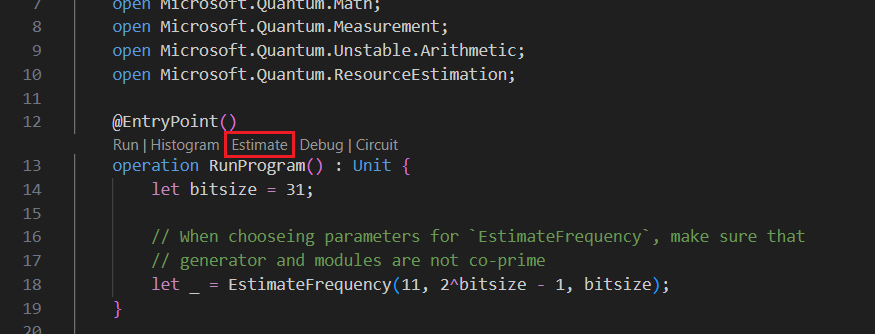
リソースを推定する 1 つ以上の 量子ビット パラメーターとエラー修正コード の種類を選択できます。 この例では、[ qubit_gate_us_e3 ] を選択し、[OK] をクリック します。

エラー予算を指定するか、既定値 0.001 をそのまま使用します。 この例では、既定値のままにして Enter キーを押 します。
Enter キーを押して、ファイル名 (この場合は ShorRE) に基づいて既定の結果名をそのまま使用します。
結果の確認
Resource Estimator は、同じアルゴリズムに対して複数の見積もりを提供し、それぞれが量子ビット数とランタイムの間のトレードオフを示します。 ランタイムとシステムスケールのトレードオフを理解することは、リソース推定の最も重要な側面の 1 つです。
リソース推定の結果は、[ Q# 見積もり ] ウィンドウに表示されます。
[ 結果 ] タブには、リソース推定の概要が表示されます。 最初の行の 横にあるアイコンをクリックして、表示する列を選択します。 実行名、推定の種類、量子ビットの種類、qec スキーム、エラー予算、論理量子ビット、論理深さ、コード距離、T 状態、T ファクトリ、T ファクトリ、T ファクトリ分数、ランタイム、rQOPS、物理量子ビットから選択できます。
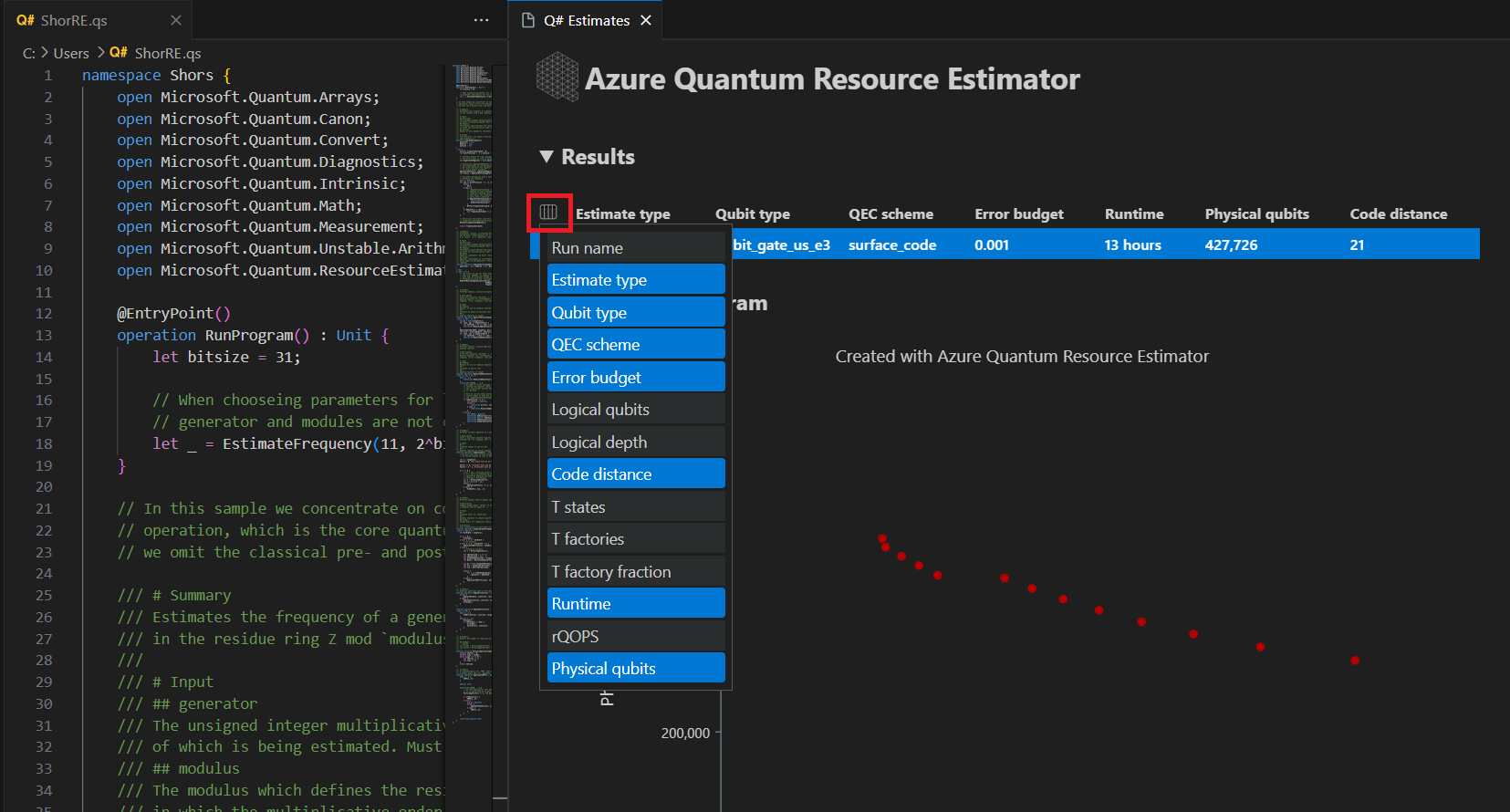
結果テーブルの [推定の種類 ] 列では、アルゴリズムの {量子ビット数、ランタイム} の最適な組み合わせの数を確認できます。 これらの組み合わせは、時空間図で確認できます。
時空間図は、物理量子ビットの数とアルゴリズムのランタイムのトレードオフを示しています。 この場合、Resource Estimator は、可能な数千の組み合わせのうち、13 種類の最適な組み合わせを検出します。 各 {量子ビット数、ランタイム} ポイントにカーソルを合わせると、その時点でのリソース推定の詳細を確認できます。
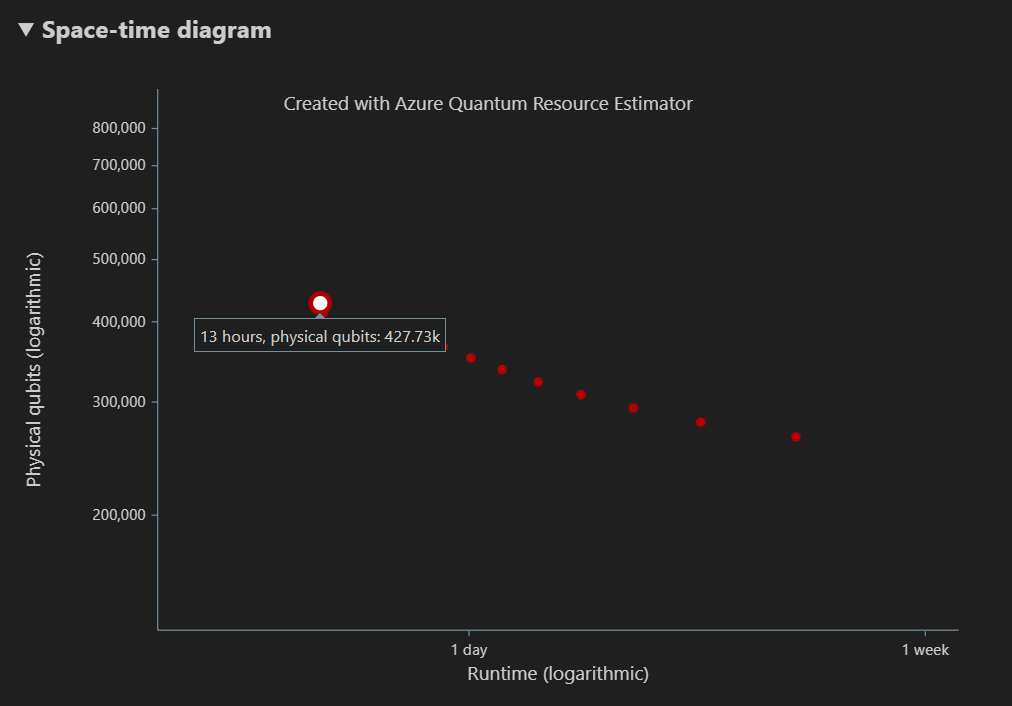
詳細については、「 時空間図」を参照してください。
注意
空間ダイアグラムとそのポイントに対応するリソース推定の詳細を表示するには、時空間ダイアグラムの 1 つのポイント ({number of qubits, runtime} ペア) をクリックする必要があります。
Space 図は、{number of qubits, runtime} ペアに対応する、アルゴリズムと T ファクトリに使用される物理量子ビットの分布を示しています。 たとえば、時空間図の左端のポイントを選択すると、アルゴリズムの実行に必要な物理量子ビットの数が427726されます。その196686はアルゴリズム量子ビットで、そのうちの 231040 は T ファクトリ量子ビットです。

最後に、{number of qubits, runtime} ペアに対応する Resource Estimator の出力データの完全な一覧が [リソース見積もり] タブに表示されます。 詳しい情報が含まれているグループを折りたたんで、コストの詳細を確認できます。 たとえば、時空間ダイアグラムの左端のポイントを選択し、[ 論理量子ビット パラメーター] グループを折りたたみます。
論理量子ビット パラメーター 値 QEC スキーム surface_code コード距離 21 物理量子ビット 882 論理サイクル時間 13 ミリセクス 論理量子ビット エラー率 3.00E-13 交差の前要素 0.03 エラー修正しきい値 0.01 論理サイクル時間の数式 (4 * twoQubitGateTime+ 2 *oneQubitMeasurementTime) *codeDistance物理量子ビットの数式 2 * codeDistance*codeDistanceヒント
[ 詳細な行の表示 ] をクリックして、レポート データの各出力の説明を表示します。
詳細については、 Resource Estimator の完全なレポート データを参照してください。
パラメーターを変更するtarget
他の量子ビットの種類、エラー修正コード、エラー予算を使用して、同じ Q# プログラムのコストを見積もることができます。 [ 表示 ] -> [コマンド パレット] を選択して [リソース推定ツール] ウィンドウを開き、「」と入力します Q#: Calculate Resource Estimates。
Majorana ベースの量子ビット パラメーターなど、その他の構成を選択します qubit_maj_ns_e6。 既定のエラー予算値をそのまま使用するか、新しい予算値を入力して、 Enter キーを押します。 Resource Estimator は、新しい target パラメーターを使用して推定を再実行します。
詳細については、「Resource Estimator の ターゲット パラメーター 」を参照してください。
パラメーターの複数の構成を実行する
Azure Quantum Resource Estimator では、パラメーターの複数の target 構成を実行し、リソース推定結果を比較できます。
[ 表示 -> コマンド パレット] を選択するか、 Ctrl + Shift + P キーを押して、「 」と入力します
Q#: Calculate Resource Estimates。[qubit_gate_us_e3]、[qubit_gate_us_e4]、[qubit_maj_ns_e4 + floquet_code]、[+ floquet_code] のqubit_maj_ns_e6を選択し、[OK] をクリックします。
既定のエラー予算値 0.001 をそのまま使用し、Enter キーを押 します。
Enter キーを押して入力ファイル (この場合は ShorRE.qs) を受け入れます。
複数のパラメーター構成の場合、結果は [ 結果 ] タブに異なる行に表示されます。
時空間図は、パラメーターのすべての構成の結果を示しています。 結果テーブルの最初の列には、パラメーターの構成ごとの凡例が表示されます。 各ポイントにカーソルを合わせると、その時点でのリソース推定の詳細を確認できます。
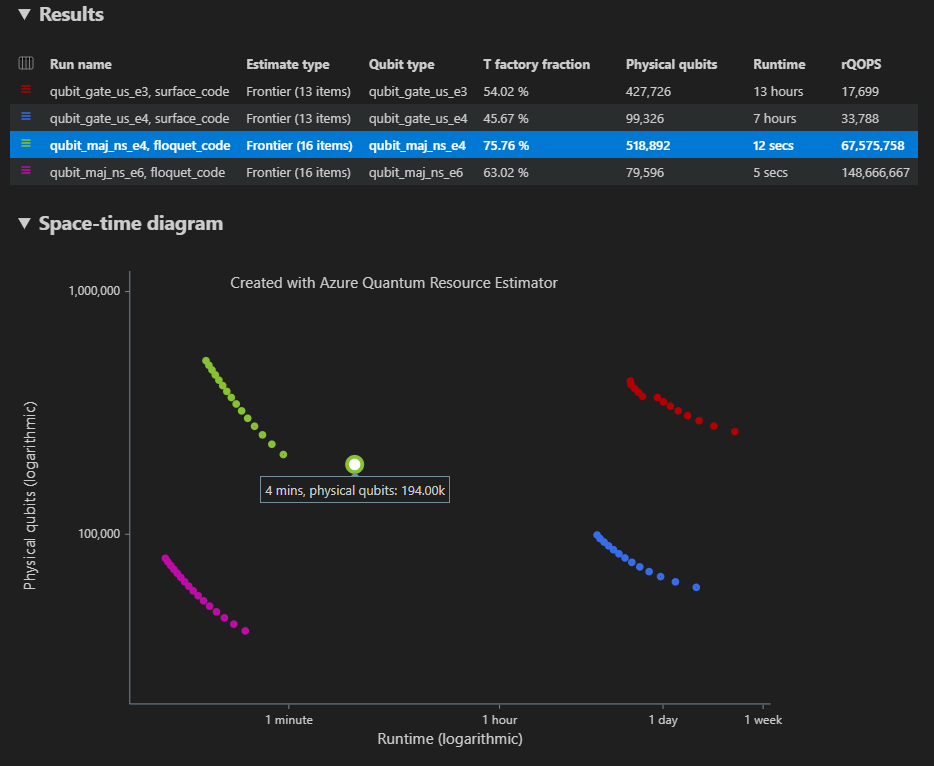
時空間図 の {number of qubits, runtime} ポイント をクリックして、対応する空間ダイアグラムとレポート データを表示します。
VS Code でのJupyter Notebookの前提条件
Python と Pip がインストールされている Python 環境。
最新バージョンの Visual Studio Code または WEB 上の VS Code を開きます。
Azure Quantum Development Kit、Python、Jupyter 拡張機能がインストールされた VS Code。
最新の Azure Quantum
qsharpとqsharp-widgetsパッケージ。python -m pip install --upgrade qsharp qsharp-widgets
ヒント
ローカル リソース推定ツールを実行するために Azure アカウントを持っている必要はありません。
量子アルゴリズムをCreateする
VS Code で、[コマンド パレットの表示>] を選択し、[Create: 新しいJupyter Notebook] を選択します。
右上では、VS Code によって、ノートブック用に選択された Python のバージョンと仮想 Python 環境が検出され、表示されます。 複数の Python 環境がある場合は、右上のカーネル ピッカーを使用してカーネルを選択する必要がある場合があります。 環境が検出されなかった場合は、セットアップ情報については 、「VS Code の Jupyter Notebooks 」を参照してください。
ノートブックの最初のセルで、パッケージをインポートします
qsharp。import qsharp新しいセルを追加し、次のコードをコピーします。
%%qsharp open Microsoft.Quantum.Arrays; open Microsoft.Quantum.Canon; open Microsoft.Quantum.Convert; open Microsoft.Quantum.Diagnostics; open Microsoft.Quantum.Intrinsic; open Microsoft.Quantum.Math; open Microsoft.Quantum.Measurement; open Microsoft.Quantum.Unstable.Arithmetic; open Microsoft.Quantum.ResourceEstimation; operation RunProgram() : Unit { let bitsize = 31; // When choosing parameters for `EstimateFrequency`, make sure that // generator and modules are not co-prime let _ = EstimateFrequency(11, 2^bitsize - 1, bitsize); } // In this sample we concentrate on costing the `EstimateFrequency` // operation, which is the core quantum operation in Shors algorithm, and // we omit the classical pre- and post-processing. /// # Summary /// Estimates the frequency of a generator /// in the residue ring Z mod `modulus`. /// /// # Input /// ## generator /// The unsigned integer multiplicative order (period) /// of which is being estimated. Must be co-prime to `modulus`. /// ## modulus /// The modulus which defines the residue ring Z mod `modulus` /// in which the multiplicative order of `generator` is being estimated. /// ## bitsize /// Number of bits needed to represent the modulus. /// /// # Output /// The numerator k of dyadic fraction k/2^bitsPrecision /// approximating s/r. operation EstimateFrequency( generator : Int, modulus : Int, bitsize : Int ) : Int { mutable frequencyEstimate = 0; let bitsPrecision = 2 * bitsize + 1; // Allocate qubits for the superposition of eigenstates of // the oracle that is used in period finding. use eigenstateRegister = Qubit[bitsize]; // Initialize eigenstateRegister to 1, which is a superposition of // the eigenstates we are estimating the phases of. // We first interpret the register as encoding an unsigned integer // in little endian encoding. ApplyXorInPlace(1, eigenstateRegister); let oracle = ApplyOrderFindingOracle(generator, modulus, _, _); // Use phase estimation with a semiclassical Fourier transform to // estimate the frequency. use c = Qubit(); for idx in bitsPrecision - 1..-1..0 { within { H(c); } apply { // `BeginEstimateCaching` and `EndEstimateCaching` are the operations // exposed by Azure Quantum Resource Estimator. These will instruct // resource counting such that the if-block will be executed // only once, its resources will be cached, and appended in // every other iteration. if BeginEstimateCaching("ControlledOracle", SingleVariant()) { Controlled oracle([c], (1 <<< idx, eigenstateRegister)); EndEstimateCaching(); } R1Frac(frequencyEstimate, bitsPrecision - 1 - idx, c); } if MResetZ(c) == One { set frequencyEstimate += 1 <<< (bitsPrecision - 1 - idx); } } // Return all the qubits used for oracle eigenstate back to 0 state // using Microsoft.Quantum.Intrinsic.ResetAll. ResetAll(eigenstateRegister); return frequencyEstimate; } /// # Summary /// Interprets `target` as encoding unsigned little-endian integer k /// and performs transformation |k⟩ ↦ |gᵖ⋅k mod N ⟩ where /// p is `power`, g is `generator` and N is `modulus`. /// /// # Input /// ## generator /// The unsigned integer multiplicative order ( period ) /// of which is being estimated. Must be co-prime to `modulus`. /// ## modulus /// The modulus which defines the residue ring Z mod `modulus` /// in which the multiplicative order of `generator` is being estimated. /// ## power /// Power of `generator` by which `target` is multiplied. /// ## target /// Register interpreted as little endian encoded which is multiplied by /// given power of the generator. The multiplication is performed modulo /// `modulus`. internal operation ApplyOrderFindingOracle( generator : Int, modulus : Int, power : Int, target : Qubit[] ) : Unit is Adj + Ctl { // The oracle we use for order finding implements |x⟩ ↦ |x⋅a mod N⟩. We // also use `ExpModI` to compute a by which x must be multiplied. Also // note that we interpret target as unsigned integer in little-endian // encoding. ModularMultiplyByConstant(modulus, ExpModI(generator, power, modulus), target); } /// # Summary /// Performs modular in-place multiplication by a classical constant. /// /// # Description /// Given the classical constants `c` and `modulus`, and an input /// quantum register |𝑦⟩, this operation /// computes `(c*x) % modulus` into |𝑦⟩. /// /// # Input /// ## modulus /// Modulus to use for modular multiplication /// ## c /// Constant by which to multiply |𝑦⟩ /// ## y /// Quantum register of target internal operation ModularMultiplyByConstant(modulus : Int, c : Int, y : Qubit[]) : Unit is Adj + Ctl { use qs = Qubit[Length(y)]; for (idx, yq) in Enumerated(y) { let shiftedC = (c <<< idx) % modulus; Controlled ModularAddConstant([yq], (modulus, shiftedC, qs)); } ApplyToEachCA(SWAP, Zipped(y, qs)); let invC = InverseModI(c, modulus); for (idx, yq) in Enumerated(y) { let shiftedC = (invC <<< idx) % modulus; Controlled ModularAddConstant([yq], (modulus, modulus - shiftedC, qs)); } } /// # Summary /// Performs modular in-place addition of a classical constant into a /// quantum register. /// /// # Description /// Given the classical constants `c` and `modulus`, and an input /// quantum register |𝑦⟩, this operation /// computes `(x+c) % modulus` into |𝑦⟩. /// /// # Input /// ## modulus /// Modulus to use for modular addition /// ## c /// Constant to add to |𝑦⟩ /// ## y /// Quantum register of target internal operation ModularAddConstant(modulus : Int, c : Int, y : Qubit[]) : Unit is Adj + Ctl { body (...) { Controlled ModularAddConstant([], (modulus, c, y)); } controlled (ctrls, ...) { // We apply a custom strategy to control this operation instead of // letting the compiler create the controlled variant for us in which // the `Controlled` functor would be distributed over each operation // in the body. // // Here we can use some scratch memory to save ensure that at most one // control qubit is used for costly operations such as `AddConstant` // and `CompareGreaterThenOrEqualConstant`. if Length(ctrls) >= 2 { use control = Qubit(); within { Controlled X(ctrls, control); } apply { Controlled ModularAddConstant([control], (modulus, c, y)); } } else { use carry = Qubit(); Controlled AddConstant(ctrls, (c, y + [carry])); Controlled Adjoint AddConstant(ctrls, (modulus, y + [carry])); Controlled AddConstant([carry], (modulus, y)); Controlled CompareGreaterThanOrEqualConstant(ctrls, (c, y, carry)); } } } /// # Summary /// Performs in-place addition of a constant into a quantum register. /// /// # Description /// Given a non-empty quantum register |𝑦⟩ of length 𝑛+1 and a positive /// constant 𝑐 < 2ⁿ, computes |𝑦 + c⟩ into |𝑦⟩. /// /// # Input /// ## c /// Constant number to add to |𝑦⟩. /// ## y /// Quantum register of second summand and target; must not be empty. internal operation AddConstant(c : Int, y : Qubit[]) : Unit is Adj + Ctl { // We are using this version instead of the library version that is based // on Fourier angles to show an advantage of sparse simulation in this sample. let n = Length(y); Fact(n > 0, "Bit width must be at least 1"); Fact(c >= 0, "constant must not be negative"); Fact(c < 2 ^ n, $"constant must be smaller than {2L ^ n}"); if c != 0 { // If c has j trailing zeroes than the j least significant bits // of y will not be affected by the addition and can therefore be // ignored by applying the addition only to the other qubits and // shifting c accordingly. let j = NTrailingZeroes(c); use x = Qubit[n - j]; within { ApplyXorInPlace(c >>> j, x); } apply { IncByLE(x, y[j...]); } } } /// # Summary /// Performs greater-than-or-equals comparison to a constant. /// /// # Description /// Toggles output qubit `target` if and only if input register `x` /// is greater than or equal to `c`. /// /// # Input /// ## c /// Constant value for comparison. /// ## x /// Quantum register to compare against. /// ## target /// Target qubit for comparison result. /// /// # Reference /// This construction is described in [Lemma 3, arXiv:2201.10200] internal operation CompareGreaterThanOrEqualConstant(c : Int, x : Qubit[], target : Qubit) : Unit is Adj+Ctl { let bitWidth = Length(x); if c == 0 { X(target); } elif c >= 2 ^ bitWidth { // do nothing } elif c == 2 ^ (bitWidth - 1) { ApplyLowTCNOT(Tail(x), target); } else { // normalize constant let l = NTrailingZeroes(c); let cNormalized = c >>> l; let xNormalized = x[l...]; let bitWidthNormalized = Length(xNormalized); let gates = Rest(IntAsBoolArray(cNormalized, bitWidthNormalized)); use qs = Qubit[bitWidthNormalized - 1]; let cs1 = [Head(xNormalized)] + Most(qs); let cs2 = Rest(xNormalized); within { for i in IndexRange(gates) { (gates[i] ? ApplyAnd | ApplyOr)(cs1[i], cs2[i], qs[i]); } } apply { ApplyLowTCNOT(Tail(qs), target); } } } /// # Summary /// Internal operation used in the implementation of GreaterThanOrEqualConstant. internal operation ApplyOr(control1 : Qubit, control2 : Qubit, target : Qubit) : Unit is Adj { within { ApplyToEachA(X, [control1, control2]); } apply { ApplyAnd(control1, control2, target); X(target); } } internal operation ApplyAnd(control1 : Qubit, control2 : Qubit, target : Qubit) : Unit is Adj { body (...) { CCNOT(control1, control2, target); } adjoint (...) { H(target); if (M(target) == One) { X(target); CZ(control1, control2); } } } /// # Summary /// Returns the number of trailing zeroes of a number /// /// ## Example /// ```qsharp /// let zeroes = NTrailingZeroes(21); // = NTrailingZeroes(0b1101) = 0 /// let zeroes = NTrailingZeroes(20); // = NTrailingZeroes(0b1100) = 2 /// ``` internal function NTrailingZeroes(number : Int) : Int { mutable nZeroes = 0; mutable copy = number; while (copy % 2 == 0) { set nZeroes += 1; set copy /= 2; } return nZeroes; } /// # Summary /// An implementation for `CNOT` that when controlled using a single control uses /// a helper qubit and uses `ApplyAnd` to reduce the T-count to 4 instead of 7. internal operation ApplyLowTCNOT(a : Qubit, b : Qubit) : Unit is Adj+Ctl { body (...) { CNOT(a, b); } adjoint self; controlled (ctls, ...) { // In this application this operation is used in a way that // it is controlled by at most one qubit. Fact(Length(ctls) <= 1, "At most one control line allowed"); if IsEmpty(ctls) { CNOT(a, b); } else { use q = Qubit(); within { ApplyAnd(Head(ctls), a, q); } apply { CNOT(q, b); } } } controlled adjoint self; }
量子アルゴリズムを推定する
次に、既定の前提条件を使用して、操作の RunProgram 物理リソースを見積もります。 新しいセルを追加し、次のコードをコピーします。
result = qsharp.estimate("RunProgram()")
result
関数は qsharp.estimate 結果オブジェクトを作成します。このオブジェクトを使用すると、物理リソースの全体的な数を含むテーブルを表示できます。 詳しい情報が含まれているグループを折りたたんで、コストの詳細を確認できます。 詳細については、 Resource Estimator の完全なレポート データを参照してください。
たとえば、 論理量子ビット パラメーター グループを折りたたんで、コード距離が 21 で、物理量子ビットの数が 882 であることを確認します。
| 論理量子ビット パラメーター | 値 |
|---|---|
| QEC スキーム | surface_code |
| コード距離 | 21 |
| 物理量子ビット | 882 |
| 論理サイクル時間 | 8 ミリセクス |
| 論理量子ビット エラー率 | 3.00E-13 |
| 交差の前要素 | 0.03 |
| エラー修正しきい値 | 0.01 |
| 論理サイクル時間の数式 | (4 * twoQubitGateTime + 2 * oneQubitMeasurementTime) * codeDistance |
| 物理量子ビットの数式 | 2 * codeDistance * codeDistance |
ヒント
よりコンパクトなバージョンの出力テーブルの場合は、 を使用 result.summaryできます。
スペースダイアグラム
アルゴリズムと T ファクトリに使用される物理量子ビットの分布は、アルゴリズムの設計に影響を与える可能性のある要因です。 パッケージを使用してこの分布を qsharp-widgets 視覚化し、アルゴリズムの推定領域要件をより深く理解できます。
from qsharp-widgets import SpaceChart, EstimateDetails
SpaceChart(result)
この例では、アルゴリズムの実行に必要な物理量子ビットの数は829766 196686、そのうちの 633080 はアルゴリズム量子ビット、そのうち 633080 は T ファクトリ量子ビットです。
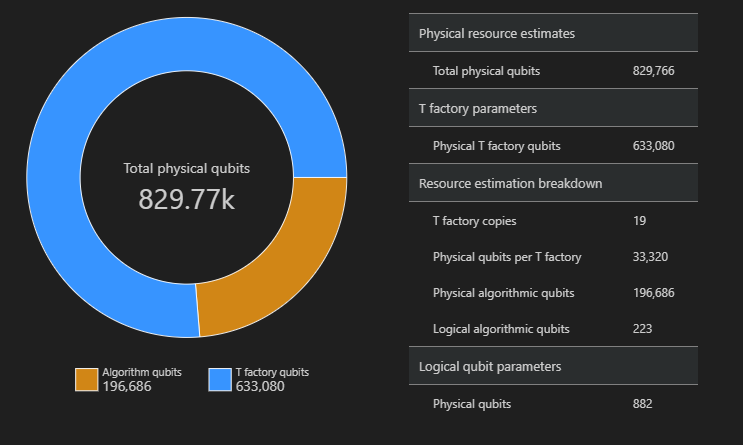
既定値を変更し、アルゴリズムを推定する
プログラムのリソース見積もり要求を送信するときに、いくつかの省略可能なパラメーターを指定できます。 フィールドを jobParams 使用して、ジョブの実行に target 渡すことができるすべてのパラメーターにアクセスし、想定された既定値を確認します。
result['jobParams']
{'errorBudget': 0.001,
'qecScheme': {'crossingPrefactor': 0.03,
'errorCorrectionThreshold': 0.01,
'logicalCycleTime': '(4 * twoQubitGateTime + 2 * oneQubitMeasurementTime) * codeDistance',
'name': 'surface_code',
'physicalQubitsPerLogicalQubit': '2 * codeDistance * codeDistance'},
'qubitParams': {'instructionSet': 'GateBased',
'name': 'qubit_gate_ns_e3',
'oneQubitGateErrorRate': 0.001,
'oneQubitGateTime': '50 ns',
'oneQubitMeasurementErrorRate': 0.001,
'oneQubitMeasurementTime': '100 ns',
'tGateErrorRate': 0.001,
'tGateTime': '50 ns',
'twoQubitGateErrorRate': 0.001,
'twoQubitGateTime': '50 ns'}}
Resource Estimator が、見積もりの既定値として量子ビット モデル、surface_codeエラー修正コード、0.001 エラー予算を受け取るqubit_gate_ns_e3ことがわかります。
targetカスタマイズできるパラメーターは次のとおりです。
errorBudget- アルゴリズムに対して許可される全体的なエラー予算qecScheme- 量子エラー修正 (QEC) スキームqubitParams- 物理量子ビット パラメーターconstraints- コンポーネント レベルの制約distillationUnitSpecifications- T 工場蒸留アルゴリズムの仕様estimateType- 単一またはフロンティア
詳細については、「Resource Estimator の ターゲット パラメーター 」を参照してください。
量子ビット モデルの変更
同じアルゴリズムのコストは、Majorana ベースの量子ビット パラメーター qubitParams、"qubit_maj_ns_e6" を使用して見積もることができます。
result_maj = qsharp.estimate("RunProgram()", params={
"qubitParams": {
"name": "qubit_maj_ns_e6"
}})
EstimateDetails(result_maj)
量子エラー修正スキームの変更
Majorana ベースの量子ビット パラメーターで、同じ例のリソース推定ジョブを、フロー QEC スキーム qecScheme( ) で再実行できます。
result_maj = qsharp.estimate("RunProgram()", params={
"qubitParams": {
"name": "qubit_maj_ns_e6"
},
"qecScheme": {
"name": "floquet_code"
}})
EstimateDetails(result_maj)
エラーの予算を変更する
次に、 が 10% の同じ量子回路を errorBudget 再実行します。
result_maj = qsharp.estimate("RunProgram()", params={
"qubitParams": {
"name": "qubit_maj_ns_e6"
},
"qecScheme": {
"name": "floquet_code"
},
"errorBudget": 0.1})
EstimateDetails(result_maj)
リソース推定器を使用したバッチ処理
Azure Quantum Resource Estimator を使用すると、パラメーターの複数の target 構成を実行し、結果を比較できます。 これは、さまざまな量子ビット モデル、QEC スキーム、またはエラー予算のコストを比較する場合に便利です。
バッチ推定を実行するには、パラメーターの一覧を関数のtarget
qsharp.estimateパラメーターにparams渡します。 たとえば、既定のパラメーターと Majorana ベースの量子ビット パラメーターを使用して同じアルゴリズムを実行し、QEC スキームを構成します。result_batch = qsharp.estimate("RunProgram()", params= [{}, # Default parameters { "qubitParams": { "name": "qubit_maj_ns_e6" }, "qecScheme": { "name": "floquet_code" } }]) result_batch.summary_data_frame(labels=["Gate-based ns, 10⁻³", "Majorana ns, 10⁻⁶"])モデル 論理量子ビット 論理的な深さ T 状態 コード距離 T ファクトリ T ファクトリ小数 物理量子ビット rQOPS 物理ランタイム ゲートベースの ns、10⁻³ 223 3.64M 4.70M 21 19 76.30 % 829.77k 26.55M 31 秒 Majorana の ns、10⁻⁶ 223 3.64M 4.70M 5 19 63.02 % 79.60k 148.67M 5 秒 クラスを使用して推定パラメーターの一覧を
EstimatorParams作成することもできます。from qsharp.estimator import EstimatorParams, QubitParams, QECScheme, LogicalCounts labels = ["Gate-based µs, 10⁻³", "Gate-based µs, 10⁻⁴", "Gate-based ns, 10⁻³", "Gate-based ns, 10⁻⁴", "Majorana ns, 10⁻⁴", "Majorana ns, 10⁻⁶"] params = EstimatorParams(num_items=6) params.error_budget = 0.333 params.items[0].qubit_params.name = QubitParams.GATE_US_E3 params.items[1].qubit_params.name = QubitParams.GATE_US_E4 params.items[2].qubit_params.name = QubitParams.GATE_NS_E3 params.items[3].qubit_params.name = QubitParams.GATE_NS_E4 params.items[4].qubit_params.name = QubitParams.MAJ_NS_E4 params.items[4].qec_scheme.name = QECScheme.FLOQUET_CODE params.items[5].qubit_params.name = QubitParams.MAJ_NS_E6 params.items[5].qec_scheme.name = QECScheme.FLOQUET_CODEqsharp.estimate("RunProgram()", params=params).summary_data_frame(labels=labels)モデル 論理量子ビット 論理的な深さ T 状態 コード距離 T ファクトリ T ファクトリ小数 物理量子ビット rQOPS 物理ランタイム ゲートベースの µs、10⁻³ 223 3.64M 4.70M 17 13 40.54 % 216.77k 21.86k 10 時間 ゲートベースの µs、10⁻⁴ 223 3.64M 4.70M 9 14 43.17 % 63.57k 41.30k 5 時間 ゲートベースの ns、10⁻³ 223 3.64M 4.70M 17 16 69.08 % 416.89k 32.79M 25 秒 ゲートベースの ns、10⁻⁴ 223 3.64M 4.70M 9 14 43.17 % 63.57k 61.94M 13 秒 Majorana の ns、10⁻⁴ 223 3.64M 4.70M 9 19 82.75 % 501.48k 82.59M 10 秒 Majorana の ns、10⁻⁶ 223 3.64M 4.70M 5 13 31.47 % 42.96k 148.67M 5 秒
パレートフロンティア推定の実行
アルゴリズムのリソースを見積もる場合は、物理量子ビットの数とアルゴリズムのランタイムのトレードオフを考慮することが重要です。 アルゴリズムの実行時間を短縮するために、可能な限り多くの物理量子ビットの割り当てを検討できます。 ただし、物理量子ビットの数は、量子ハードウェアで使用可能な物理量子ビットの数によって制限されます。
パレートフロンティア推定では、同じアルゴリズムに対して複数の推定値が提供され、それぞれが量子ビット数とランタイムの間のトレードオフを伴います。
パレートフロンティア推定を使用してリソース推定器を実行するには、 パラメーターを として
"frontier"指定する"estimateType"target必要があります。 たとえば、パレートフロンティア推定を使用して、サーフェス コードを使用して、Majorana ベースの量子ビット パラメーターを使用して同じアルゴリズムを実行します。result = qsharp.estimate("RunProgram()", params= {"qubitParams": { "name": "qubit_maj_ns_e4" }, "qecScheme": { "name": "surface_code" }, "estimateType": "frontier", # frontier estimation } )関数を
EstimatesOverview使用すると、物理リソースの合計数を含むテーブルを表示できます。 最初の行の横にあるアイコンをクリックして、表示する列を選択します。 実行名、推定の種類、量子ビットの種類、qec スキーム、エラー予算、論理量子ビット、論理深さ、コード距離、T 状態、T ファクトリ、T ファクトリ、T ファクトリ分数、ランタイム、rQOPS、物理量子ビットから選択できます。from qsharp_widgets import EstimatesOverview EstimatesOverview(result)
結果テーブルの [推定の種類 ] 列では、アルゴリズムの {量子ビット数、ランタイム} の異なる組み合わせの数を確認できます。 この場合、Resource Estimator は、可能な数千の組み合わせのうち、22 種類の最適な組み合わせを検出します。
時空間図
この関数には EstimatesOverview 、リソース推定器 の時空間図 も表示されます。
時空間図は、{量子ビット数、ランタイム} ペアごとの物理量子ビットの数とアルゴリズムのランタイムを示しています。 各ポイントにマウス ポインターを合わせると、その時点でのリソース推定の詳細を確認できます。
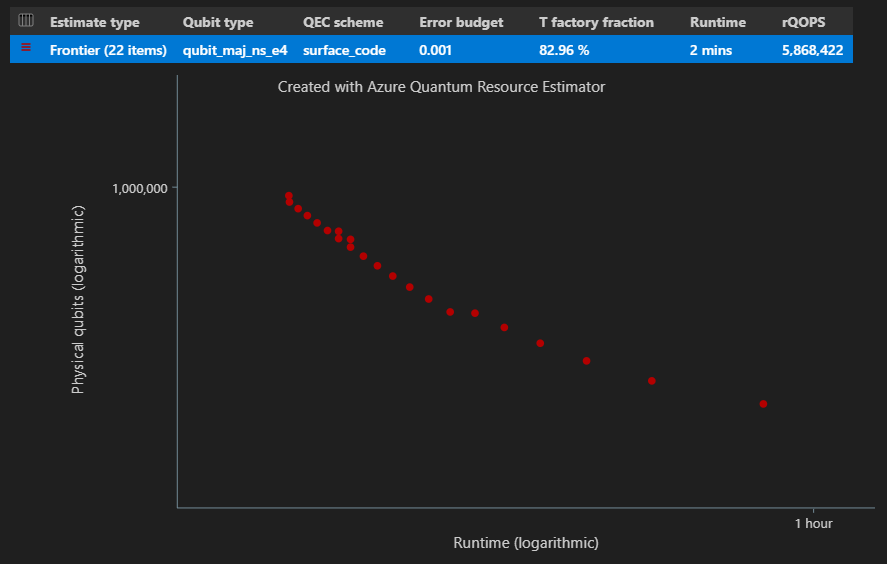
パレートフロンティア推定によるバッチ処理
パラメーターの複数の target 構成をフロンティア推定と推定して比較するには、 パラメーターに を追加
"estimateType": "frontier",します。result = qsharp.estimate( "RunProgram()", [ { "qubitParams": { "name": "qubit_maj_ns_e4" }, "qecScheme": { "name": "surface_code" }, "estimateType": "frontier", # Pareto frontier estimation }, { "qubitParams": { "name": "qubit_maj_ns_e6" }, "qecScheme": { "name": "floquet_code" }, "estimateType": "frontier", # Pareto frontier estimation }, ] ) EstimatesOverview(result, colors=["#1f77b4", "#ff7f0e"], runNames=["e4 Surface Code", "e6 Floquet Code"])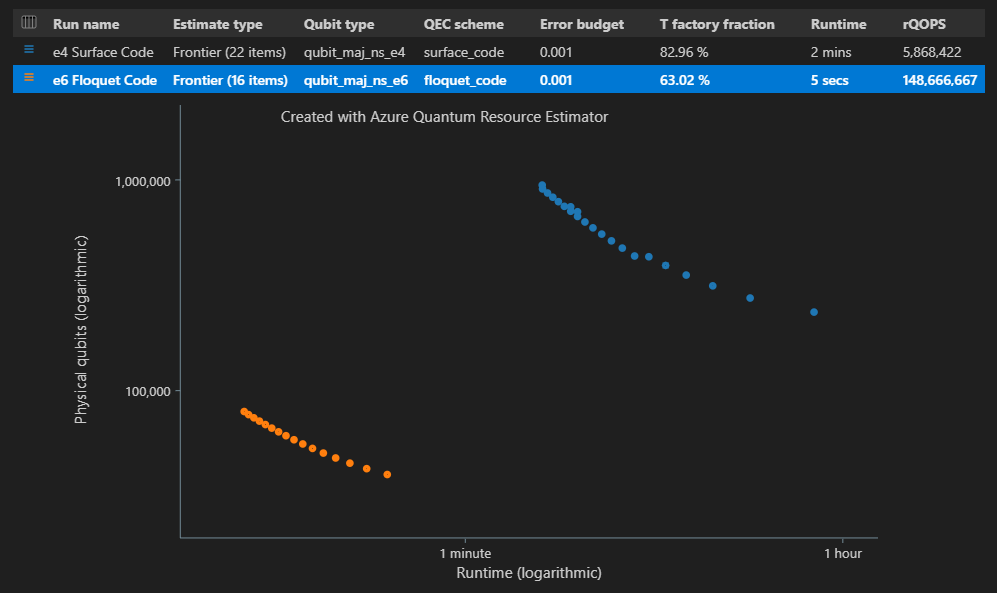
注意
関数を使用して、量子ビット時間図の色と実行名を
EstimatesOverview定義できます。パレート フロンティア推定を使用してパラメーターの複数の target 構成を実行すると、時空間図の特定のポイント (つまり、{量子ビット数、ランタイム} ペア) ごとにリソースの見積もりを確認できます。 たとえば、次のコードは、2 番目の (推定インデックス =0) 実行と 4 番目 (ポイント インデックス =3) 最短ランタイムの推定詳細の使用状況を示しています。
EstimateDetails(result[1], 4)また、時空間図の特定のポイントの空間図を確認することもできます。 たとえば、次のコードは、組み合わせの最初の実行 (推定インデックス =0) と 3 番目に短いランタイム (ポイント インデックス = 2) のスペース図を示しています。
SpaceChart(result[0], 2)
Qiskit の前提条件
- アクティブなサブスクリプションが含まれる Azure アカウント。 Azure アカウントをお持ちでない場合は、無料で登録し、 従量課金制サブスクリプションにサインアップします。
- Azure Quantum ワークスペース。 詳細については、「Azure Quantum ワークスペースを作成する」を参照してください。
ワークスペースで Azure Quantum リソース推定器 target を有効にする
リソース推定ツールは、 target Microsoft Quantum Computing プロバイダーの です。 リソース推定器のリリース以降にワークスペースを作成した場合、Microsoft Quantum Computing プロバイダーがワークスペースに自動的に追加されました。
既存の Azure Quantum ワークスペースを使用している場合:
- Azure Portal でワークスペースを開きます。
- 左側のパネルで、[演算] の [プロバイダー] を選択します。
- [+ プロバイダーの追加] を選択します。
- [Microsoft 量子コンピューティング] の [+ 追加] を選択します。
- [ 開発 & 学習 ] を選択し、[ 追加] を選択します。
ワークスペースに新しいノートブックを作成する
- Azure portal にログインし、Azure Quantum ワークスペースを選択します。
- [ 操作] で[ノートブック] を選択 します
- [マイ ノートブック] をクリックし、[新規追加] をクリックします。
- [カーネルの種類] で、[IPython] を選択します。
- ファイルの名前を入力し、[ファイルのCreate] をクリックします。
新しいノートブックが開くと、サブスクリプションとワークスペースの情報に基づいて、最初のセルのコードが自動的に作成されます。
from azure.quantum import Workspace
workspace = Workspace (
resource_id = "", # Your resource_id
location = "" # Your workspace location (for example, "westus")
)
Note
特に記載がない限り、コンパイルの問題が発生しないように、各セルは作成した順序で実行する必要があります。
セルの左側にある三角形の [再生] アイコンをクリックして、このコードを実行します。
必要なインポートを読み込む
まず、 azure-quantum と qiskitから追加のモジュールをインポートする必要があります。
[+ コード] をクリックして新しいセルを追加した後、次のコードを追加して実行します。
from azure.quantum.qiskit import AzureQuantumProvider
from qiskit import QuantumCircuit, transpile
from qiskit.circuit.library import RGQFTMultiplier
Azure Quantum サービスに接続する
次に、前のセルの オブジェクトを使用して workspaceAzureQuantumProvider オブジェクトを作成し、Azure Quantum ワークスペースに接続します。 バックエンド インスタンスを作成し、Resource Estimator を として設定します target。
provider = AzureQuantumProvider(workspace)
backend = provider.get_backend('microsoft.estimator')
量子アルゴリズムをCreateする
この例では、 Ruiz-Perez と Garcia-Escartin (arXiv:1411.5949) で提示された構成に基づいて、乗数の量子回路を作成します。これは、Quantum フーリエ変換を使用して算術演算を実装します。
変数を変更することで、乗数のサイズを bitwidth 調整できます。 回路生成は、乗数の値を使用して呼び出すことができる関数で bitwidth ラップされます。 操作には、指定した のサイズごとに 2 つの入力レジスタと、指定した bitwidthのサイズの 2 倍の 1 つの出力レジスタがあります bitwidth。 関数は、量子回路から直接抽出された乗数の論理リソース数も出力します。
def create_algorithm(bitwidth):
print(f"[INFO] Create a QFT-based multiplier with bitwidth {bitwidth}")
# Print a warning for large bitwidths that will require some time to generate and
# transpile the circuit.
if bitwidth > 18:
print(f"[WARN] It will take more than one minute generate a quantum circuit with a bitwidth larger than 18")
circ = RGQFTMultiplier(num_state_qubits=bitwidth, num_result_qubits=2 * bitwidth)
# One could further reduce the resource estimates by increasing the optimization_level,
# however, this will also increase the runtime to construct the algorithm. Note, that
# it does not affect the runtime for resource estimation.
print(f"[INFO] Decompose circuit into intrinsic quantum operations")
circ = transpile(circ, basis_gates=SUPPORTED_INSTRUCTIONS, optimization_level=0)
# print some statistics
print(f"[INFO] qubit count: {circ.num_qubits}")
print("[INFO] gate counts")
for gate, count in circ.count_ops().items():
print(f"[INFO] - {gate}: {count}")
return circ
注意
T 状態を持たないが、少なくとも 1 つの測定値を持つアルゴリズムに対して、物理リソース推定ジョブを送信できます。
量子アルゴリズムを推定する
関数を使用してcreate_algorithmアルゴリズムのインスタンスをCreateします。 変数を変更することで、乗数のサイズを bitwidth 調整できます。
bitwidth = 4
circ = create_algorithm(bitwidth)
既定の前提条件を使用して、この操作の物理リソースを見積もります。 メソッドを使用して run Resource Estimator バックエンドに回線を送信し、 を実行 job.result() してジョブが完了し、結果が返されるのを待ちます。
job = backend.run(circ)
result = job.result()
result
これにより、全体的な物理リソース数を示すテーブルが作成されます。 詳しい情報が含まれているグループを折りたたんで、コストの詳細を確認できます。
ヒント
出力テーブルのよりコンパクトなバージョンの場合は、 を使用 result.summaryできます。
たとえば、[ 論理量子ビット パラメーター ] グループを折りたたんだ場合、エラー修正コードの距離が 15 であることがわかります。
| 論理量子ビット パラメーター | 値 |
|---|---|
| QEC スキーム | surface_code |
| コード距離 | 15 |
| 物理量子ビット | 450 |
| 論理サイクル時間 | 6us |
| 論理量子ビット エラー率 | 3.00E-10 |
| 交差前要素 | 0.03 |
| エラー修正のしきい値 | 0.01 |
| 論理サイクル時間の数式 | (4 * twoQubitGateTime + 2 * oneQubitMeasurementTime) * codeDistance |
| 物理量子ビットの数式 | 2 * codeDistance * codeDistance |
[ 物理量子ビット パラメーター] グループでは、この推定で想定されていた物理量子ビット プロパティを確認できます。 たとえば、単一量子ビット測定と単一量子ビット ゲートを実行する時間は、それぞれ 100 ns と 50 ns であると見なされます。
ヒント
result.data() メソッドを使用して、Resource Estimator の出力に Python ディクショナリとしてアクセスすることもできます。
詳細については、リソース推定器 の出力データの完全な一覧 を参照してください。
空間図
アルゴリズムと T ファクトリに使用される物理量子ビットの分布は、アルゴリズムの設計に影響を与える可能性のある要因です。 この分布を視覚化して、アルゴリズムの推定領域要件をより深く理解できます。
result.diagram.space
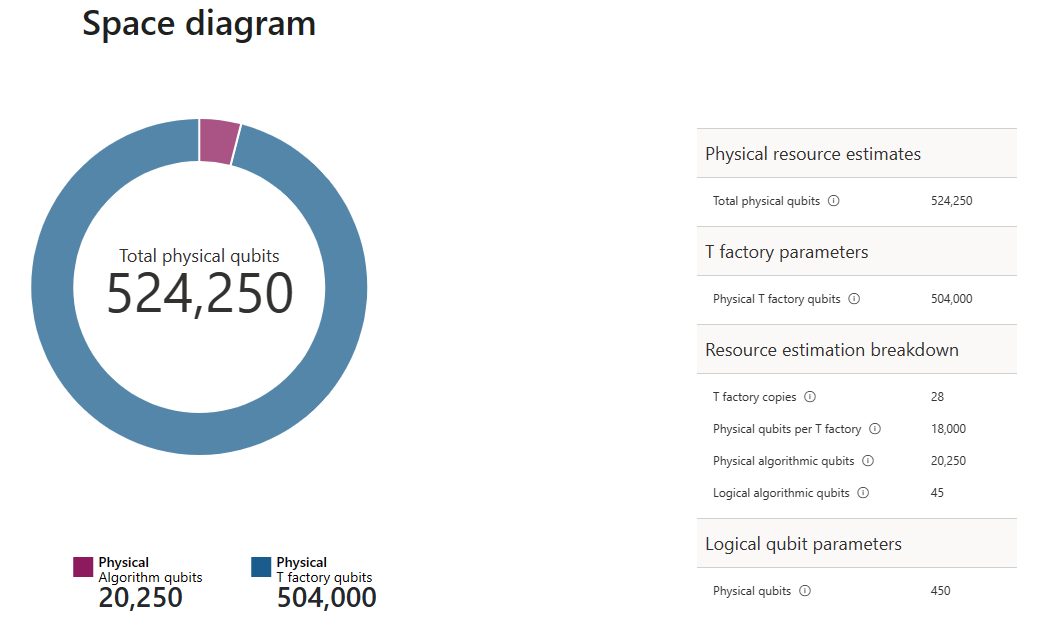
空間図は、アルゴリズム量子ビットと T ファクトリ量子ビットの割合を示しています。 T ファクトリ のコピー数 28 は、T ファクトリの物理量子ビットの数に $\text{T factories} \cdot \text{physical qubit per T factory}= 28 \cdot 18,000 = 504,000$ であることに注意してください。
詳細については、「 T ファクトリの物理的な推定」を参照してください。
既定値を変更し、アルゴリズムを推定する
プログラムのリソース見積もり要求を送信するときに、いくつかの省略可能なパラメーターを指定できます。 フィールドを jobParams 使用して、ジョブの実行に渡すことができるすべての値にアクセスし、想定されていた既定値を確認します。
result.data()["jobParams"]
{'errorBudget': 0.001,
'qecScheme': {'crossingPrefactor': 0.03,
'errorCorrectionThreshold': 0.01,
'logicalCycleTime': '(4 * twoQubitGateTime + 2 * oneQubitMeasurementTime) * codeDistance',
'name': 'surface_code',
'physicalQubitsPerLogicalQubit': '2 * codeDistance * codeDistance'},
'qubitParams': {'instructionSet': 'GateBased',
'name': 'qubit_gate_ns_e3',
'oneQubitGateErrorRate': 0.001,
'oneQubitGateTime': '50 ns',
'oneQubitMeasurementErrorRate': 0.001,
'oneQubitMeasurementTime': '100 ns',
'tGateErrorRate': 0.001,
'tGateTime': '50 ns',
'twoQubitGateErrorRate': 0.001,
'twoQubitGateTime': '50 ns'}}
targetカスタマイズできるパラメーターは次のとおりです。
errorBudget- 許容される全体的なエラー予算qecScheme- 量子エラー修正 (QEC) スキームqubitParams- 物理量子ビット パラメーターconstraints- コンポーネント レベルの制約distillationUnitSpecifications- T ファクトリ蒸留アルゴリズムの仕様
詳細については、「リソース推定器の ターゲット パラメーター 」を参照してください。
量子ビット モデルの変更
次に、Majorana ベースの量子ビット パラメーターを使用して、同じアルゴリズムのコストを見積もります qubit_maj_ns_e6
job = backend.run(circ,
qubitParams={
"name": "qubit_maj_ns_e6"
})
result = job.result()
result
物理数はプログラムで調べることができます。 たとえば、アルゴリズムを実行するために作成された T ファクトリの詳細を調べることができます。
result.data()["tfactory"]
{'eccDistancePerRound': [1, 1, 5],
'logicalErrorRate': 1.6833177305222897e-10,
'moduleNamePerRound': ['15-to-1 space efficient physical',
'15-to-1 RM prep physical',
'15-to-1 RM prep logical'],
'numInputTstates': 20520,
'numModulesPerRound': [1368, 20, 1],
'numRounds': 3,
'numTstates': 1,
'physicalQubits': 16416,
'physicalQubitsPerRound': [12, 31, 1550],
'runtime': 116900.0,
'runtimePerRound': [4500.0, 2400.0, 110000.0]}
注意
既定では、ランタイムはナノ秒単位で表示されます。
このデータを使用して、T ファクトリが必要な T 状態を生成する方法に関するいくつかの説明を生成できます。
data = result.data()
tfactory = data["tfactory"]
breakdown = data["physicalCounts"]["breakdown"]
producedTstates = breakdown["numTfactories"] * breakdown["numTfactoryRuns"] * tfactory["numTstates"]
print(f"""A single T factory produces {tfactory["logicalErrorRate"]:.2e} T states with an error rate of (required T state error rate is {breakdown["requiredLogicalTstateErrorRate"]:.2e}).""")
print(f"""{breakdown["numTfactories"]} copie(s) of a T factory are executed {breakdown["numTfactoryRuns"]} time(s) to produce {producedTstates} T states ({breakdown["numTstates"]} are required by the algorithm).""")
print(f"""A single T factory is composed of {tfactory["numRounds"]} rounds of distillation:""")
for round in range(tfactory["numRounds"]):
print(f"""- {tfactory["numModulesPerRound"][round]} {tfactory["moduleNamePerRound"][round]} unit(s)""")
A single T factory produces 1.68e-10 T states with an error rate of (required T state error rate is 2.77e-08).
23 copies of a T factory are executed 523 time(s) to produce 12029 T states (12017 are required by the algorithm).
A single T factory is composed of 3 rounds of distillation:
- 1368 15-to-1 space efficient physical unit(s)
- 20 15-to-1 RM prep physical unit(s)
- 1 15-to-1 RM prep logical unit(s)
量子エラー修正スキームの変更
次に、Floqued QEC スキーム qecScheme() を使用して、Majorana ベースの量子ビット パラメーターで同じ例のリソース推定ジョブを再実行します。
job = backend.run(circ,
qubitParams={
"name": "qubit_maj_ns_e6"
},
qecScheme={
"name": "floquet_code"
})
result_maj_floquet = job.result()
result_maj_floquet
エラーの予算を変更する
10% の で同じ量子回路を errorBudget 再実行してみましょう。
job = backend.run(circ,
qubitParams={
"name": "qubit_maj_ns_e6"
},
qecScheme={
"name": "floquet_code"
},
errorBudget=0.1)
result_maj_floquet_e1 = job.result()
result_maj_floquet_e1
注意
リソース推定ツールの使用中に問題が発生した場合は、[トラブルシューティング] ページをチェックするか、 にお問い合わせくださいAzureQuantumInfo@microsoft.com。
次の手順
フィードバック
以下は間もなく提供いたします。2024 年を通じて、コンテンツのフィードバック メカニズムとして GitHub の issue を段階的に廃止し、新しいフィードバック システムに置き換えます。 詳細については、「https://aka.ms/ContentUserFeedback」を参照してください。
フィードバックの送信と表示